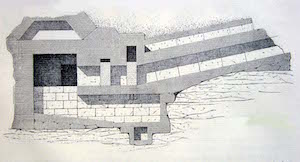Amenemhat II (of the Middle Kingdom of Ancient Egypt) was the first pharaoh to build a pyramid at Dashur after Sneferu of the Old Kingdom. The pyramid of Amenemhet II is known as the “White Pyramid” because it was originally clad in shining white limestone, but it was known to the Ancient Egyptians as “The Mighty Pyramid”, although it also seems to have been known as “Amenemhet is provided”.

Unfortunately, the pyramid was breached a number of times by robbers and it is now in a fairly poor state. Little work has been done on the pyramid and so we only have a very sketchy idea of its internal structure. The base has not been fully excavated to allow precise measurement, but is thought to be approximately fifty meters by fifty meters. Its original height and the angle of its slope are not known. The pyramid core was formed by white limestone blocks filled with sand and then cased in fine white limestone slabs.
The entrance in the north face was covered by a north chapel. From the entrance a corridor lined with limestone descends towards the burial chamber. Two granite portcullis slabs were fitted where the corridor levelled out before reaching the burial chamber.

- Pylon-like structures
- Pyramid
- Tombs
The burial chamber was located on the vertical axis of the pyramid and oriented east-west. It was fitted with a false gabled ceiling composed of large limestone slabs to spread the weight of the masonry above. A large quartzite sarcophagus was set into the floor of the burial chamber close to the west wall of this chamber. There are a four niches in the walls of this chamber (one on each side wall and two on the wall opposite the entrance) but their purpose is unclear. A shaft cut in the floor of the chamber leads down to a second corridor beneath the entrance corridor. A pit at the end of this second corridor was probably intended to hold the canopic chest of Amenhemhet II.

The pyramid was surrounded by a large rectangular enclosure wall. Within this wall excavators discovered a number of intact tombs belonging to Amenemhet’s relatives, including prince Amenemhetankh and princesses Ita, Khnumet, Itiueret and Sithathormeret. These tombs contained a variety of funerary furniture such as wooden coffins, alabaster perfume jars, and canopic chests. There was also a large quantity of beautiful jewellery in the tombs of Ita and Khnumet.
The mortuary temple on the east side of the pyramid is almost entirely ruined. We know that it was known as “Lighted is the place of Amenemhat’s pleasures” and a few fragments of decoration have been recovered but little else.
At the east side of the enclosure wall two large structures resembling pylons flanked the entrance to a causeway which probably led to the valley temple. To date, the causeway has not been excavated and the valley temple has not been found.
Bibliography
- Bard, Kathryn (2008) An introduction to the Archaeology of Ancient Egypt
- Kemp, Barry J (1991) Ancient Egypt: Anatomy of a Civilisation
- Lehner, Mark (1997) The Complete Pyramids
- Verner, Miroslav (1997)The Pyramids
Copyright J Hill 2016